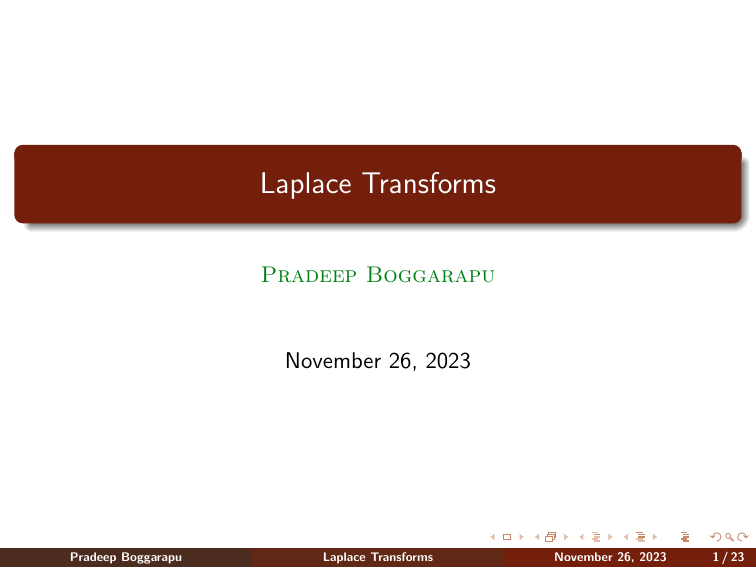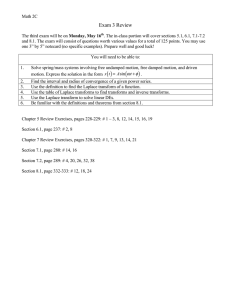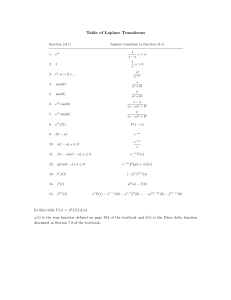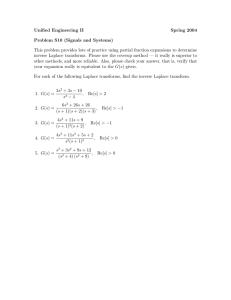
Laplace Transforms Pradeep Boggarapu November 26, 2023 Pradeep Boggarapu Laplace Transforms November 26, 2023 1 / 23 Introduction and Definition Laplace transform is an important tool to solve certain types of differential equations and integral equations. In addition to such applications, Laplace transforms also have a no.of connections with important parts of pure mathematics. We shall try to give you an adequate idea of these matters whtout going in deep detail. Before giving the definition of Laplace transforms, we will recall some known transforms. Pradeep Boggarapu Laplace Transforms November 26, 2023 2 / 23 1 Differentiation: It is a transformation which transforms a function f (x) into another function, its derivative. Generally we use D to denote the differentiation transform and it is given by D[f ](x) = f ′ (x) 2 where f (x) is differentiable function. Integration I : It is another important basic transform and it transforms a function f (x) into its integration, i.e., Z x I [f ](x) = f (t)dt, x ∈ [a, b]. a 3 Multiplication operation by a fixed function: An even simpler transformation is the operation of multiplying all functions by a specific function g (x): Mg [f ](x) = g (x)f (x), x ∈ [a, b]. Pradeep Boggarapu Laplace Transforms November 26, 2023 3 / 23 4. Integral operators: A class of linear transformations of particular important is that of the “integral operators”. We consider functions f (x) defined on finite or infinite interval a ≤ x ≤ b and we choose a fixed function K (p, x) of variable x and parameter p. Then the integral operator with kernel K (p, x) defined by Z T [f ](p) = b K (p, x)f (x)dx = F (p) a Where the function K (p, x) is called kernel of the above integral operator. In each of our examples, the function on right is called the transformation of f (x) under the corresponding transformation. If the transformation is understood from the context, then we use the capital letter F to denote the transformation of the function f (x). Pradeep Boggarapu Laplace Transforms November 26, 2023 4 / 23 Laplace transform: It is a particular case of integral operator. When a = 0, b = ∞ and the kernerl is given by K (p, x) = e −px , we obtain the special case of integral operator which is a main concern of the present chapter, and it is called Laplace transform. We denote Laplace transform of a function f (x) by L[f (x)] or simply L[f ] and it is given by Z ∞ L[f (x)](p) = e −px f (x)dx (= F (p)) 0 where p ∈ R such that the improper integral on right exists. We remind that an improper integral in the above is defined to be the following limit Z ∞ e 0 −px Z f (x)dx = lim b→∞ 0 b e −px f (x)dx. We study more about this kind of improper integral in coming section. First we find the Laplace transforms of known functions: Pradeep Boggarapu Laplace Transforms November 26, 2023 5 / 23 The following Laplace transforms are quite easy to compute R ∞ −px 1 f (x) = 1, then F (p) = dx = p1 . 0 e R ∞ −px 2 f (x) = x, then F (p) = dx = p12 . 0 xe 3 If f (x) = x α , α > −1 then F (p) = Γ(α+1) . p α+1 Solution: This can be proved as follows: The Laplace transform of f (x) is given by Z ∞ Z ∞ −px F (p) = f (x)e dx = x α e −px dx. 0 0 If we use the change of variable px = t, then the above can be reduced to Z ∞ α 1 t e −t dt F (p) = p t 0 Z ∞ 1 Γ(α + 1) = α+1 t α e −t dt = . p p α+1 0 Pradeep Boggarapu Laplace Transforms November 26, 2023 6 / 23 Example 1: f (x) = sin ax, then its Laplace transform is F (p) = Sol. Here we use the integration by parts: Z ∞ sin axe −px dx F (p) = 0 Z ∞ e −px e −px ∞ − a cos ax dx = sin ax −p 0 −p 0 Z ∞ a = cos axe −px dx p 0 Z ∞ −a a2 ∞ −px = 2 cos axe − 2 sin axe −px dx p p 0 0 a a2 − F (p) p2 p2 2 which implies 1 + pa 2 F (p) = pa2 . Thus we have F (p) = a . a2 +p 2 = a . p 2 +a2 Example 2: In a similar way we can show that the Laplace transform of p f (x) = cos ax is F (p) = p2 +a 2. Pradeep Boggarapu Laplace Transforms November 26, 2023 7 / 23 Example 3: If f (x) = e ax then F (p) = 1 p−a ; p > a. Exercise Problems: 1 2 Find the Laplace transforms L sin2 ax and L cos2 ax without integrating. How are these two transforms related to each other. Without integrating show that a , p 2 − a2 p (b) L[cosh ax] = 2 , p − a2 (a) L[sinh ax] = 3 p > |a|; p > |a|; Use the Laplace transforms of known functions to find the Laplace transforms of each of the following functions: (a) f (x) = 10; (b) f (x) = x 5 + cos 2x; (d) f (x) = 4 sin x cos x + 2e −x ; (c) f (x) = 2e 3x − sin 5x (e) f (x) = x 6 cos2 3x + x 6 sin2 3x. Pradeep Boggarapu Laplace Transforms November 26, 2023 8 / 23 A Few Remarks on the Theory: Before proceeding to the application, it is desirable to consider more carefully the circumstances under which a function has Laplace transform. For this, we need to know more about improper integrals as the Laplace transform of a functions is an improper integral. Here the kind of improper integral we consider is Z ∞ f (x)dx (0.1) 0 The improper integral (0.1) is said to converge if the limit Z b lim f (x)dx b→∞ 0 exists and in this case, the value of (0.1) is defined by Z ∞ Z b f (x)dx = lim f (x)dx. 0 Pradeep Boggarapu b→∞ 0 Laplace Transforms November 26, 2023 9 / 23 The improper integral (0.1) is said to converges absolutely, if the following improper integral converges Z ∞ f (x) dx 0 Notes: 1 If the improper integral (0.1) converges absolutely implies it converges. 2 If there exists a function g (x) ≥ 0 such that |f (x)| ≤ g (x) and R∞ 0 g (x)dx converges, then the improper integral (0.1) converges absolutely and hence converges. Next we come to our basic problem, what are the functions f (x) for which the Laplace trasnform in other words, the functions for which the R ∞ exists −px improper integral 0 e f (x)dx converges. Pradeep Boggarapu Laplace Transforms November 26, 2023 10 / 23 We know that Z ∞ e 0 −px Z f (x)dx = lim b→∞ 0 b e −px f (x)dx whenever the later limit exists otherwise the improper integral does not exist. For of the limit necessarily, for large b, the integral R b existence −px f (x)dx should be finite. For this it suffices to assume that f (x) is e 0 continuous or at least is piecewise continuous. We mean by a piecewise continuous function f (x) that f is continuous on every finite interval 0 ≤ x ≤ b, except possibly at a finite no. of points where there are jump-discontinuities. Here we are assuming that the reader knows the definition of jump discontinuity of f (x) at x = x0 . You can see the text book for the examples and graph of a piecewise continuous function. Pradeep Boggarapu Laplace Transforms November 26, 2023 11 / 23 The piecewise continuity of f (x) guarantees that the definite integral Rb −px dx exists for all b. 0 f (x)e The existence of the limit Z lim b→∞ 0 b f (x)e −px dx (0.2) depends on the behaviour of the integrand e −px f (x) for large x. In order to make sure that the integrand diminish rapidly for the convergence of (0.2), we shall further assume that f (x) is of exponential order. We say a function f (x) is of exponential order if there exist constants M ≥ 0 and c ∈ R such that for large x, |f (x)| ≤ Me cx , for x ≥ 0 (0.3) Thus, though f (x) may become infinitely large as x → ∞, it must grow less rapidly than a constant multple of some exponential function e cx . Pradeep Boggarapu Laplace Transforms November 26, 2023 12 / 23 Examples: (1) Any bounded function (like sin ax, cos ax) is of exponential order: If f (x) is bounded, then there exists M such that |f (x)| ≤ M = Me 0x . (2) Any polynomial P(x) in x is also of exponential order as we can find M > 0 such that |P(x)| ≤ Me cx , for any c > 0. 2 (3) The function f (x) = e x is not of exponential order. This can be 2 proved easily, if we suppose that the function f (x) = e x is of exponential order then we will arrive to a contradiction: Pradeep Boggarapu Laplace Transforms November 26, 2023 13 / 23 2 How?, the functions e x is of exponential order means 2 |e x | ≤ Me cx for some M and c, which implies 2 e (x−c/2) ≤ Me c 2 /4 . Now if we let x tends to ∞, the function on left goes to ∞ where as the function on right remains the same, as it is independent of x which is finite number. This leads a contradiction and hence our supposition is wrong. Thus, the 2 function e x is not of exponential order. Now we show that if a function f (x) is piecewise continuous and is of exponential order then its Laplace transform exists. By the hypothesis there exist constants M ≥ 0 and c ∈ R such that for large x, |f (x)| ≤ Me cx which implies |e −px f (x)| ≤ Me −(p−c)x . Pradeep Boggarapu Laplace Transforms November 26, 2023 14 / 23 Since the function on right hand R ∞ side of the above inequality is integrable on (0, ∞) for p > c i.e., M 0 e −(p−c)x dx converges for p > c, the Laplace transform exists by comparison test. In addition, we note that Z ∞ f (x)e −px dx |F (p)| = 0 Z ∞ ≤ |f (x)e −px |dx 0 Z ∞ ≤M e −(p−c)x dx = 0 M , p−c for p > c. So F (p) → 0 as p → ∞. Actually, it can be shown that the above property is true, whenever Laplace transform F (p) exists regardless of whether or not f (x) is piecewise continuous and of exponential order. Pradeep Boggarapu Laplace Transforms November 26, 2023 15 / 23 Thus, if ϕ(p) is a function of p with the property that its limit as p → ∞ does not exist or is not equal to zero, then it can not be the Laplace transform of any function. For example, A polynomial in p, sin p, cos p, e p , log p etc. can not be Laplace transforms of any function f (x). P(p) can be Laplace transform of a Q(p) function if the degree of P is less than that of Q. But a rational function ϕ(p) = We have shown that any piecewise continuous function f (x) of exponential order has a Laplace transform, so these conditions are sufficient for existance of Laplace transform of f (x). However, they are not necessary as the example f (x) = x −1/2 shows. This function has infinite discontinuity at x = 0, so it is not piecewise continuous, but nevertheless its integral from 0 to b exists and since it is bounded for large x its Laplace transform exists. Indeed, we can find its Laplace transform in the following way: Pradeep Boggarapu Laplace Transforms November 26, 2023 16 / 23 L[x −1/2 Z ]= ∞ e −px x −1/2 dx, 0 and the change of variable px = t gives r Z ∞ Γ(1/2) π −1/2 −1/2 −t −1/2 L[x ]=p e t dt = 1/2 = . p p 0 Now we will find Laplace transforms of some piecewise continuous functions of exponential order. In each of the following cases, the functions are piecewise continuous and of exponential order and hence find its Laplace transforms: (a) f (x) = u(x − a) where a is a positive number and u(x) is the unit step function defined by 0 if x < 0; u(x) = 1 if x ≥ 0, Pradeep Boggarapu Laplace Transforms November 26, 2023 17 / 23 (b) f (x) = [x]; where [x] denotes the greatest integer ≤ x; (c) f (x) = x − [x]; sin x if 0 ≤ x ≤ π; (d) f (x) = 0 if x > π. Sol. of (a): The given function can be written as 0 if x < a; f (x) = 1 if x ≥ a. Since |f (x)| ≤ 1, its is of exponential order and it is continuous every where except at x = a where f has jump-discontinuous and hence it is piecewise continuous function. Its Laplace transform is given by Z ∞ Z ∞ e −pa −px . F (p) = f (x)e dx = e −px dx = p 0 a Pradeep Boggarapu Laplace Transforms November 26, 2023 18 / 23 Sol. of (b): The given function can be written as f (x) = [x] = n if n ≤ x < n + 1, for some integer n. Clearly f (x) is bounded by x for x > 0 and continuous every where on R except at integer values of x where f has jump-discontinuity. Therefore, f (x) is piecewise continuous and of exponential order. Its Laplace transform is given by Z ∞ Z ∞ X −px F (p) = e f (x)dx = n 0 n=0 n+1 e −px dx n ∞ ∞ 1X 1X −np −(n+1)p n e −e ne −np 1 − e −p = = p p n=0 n=0 ∞ −p X 1−e 1 − e −p d d 1 −np e =− =− p dp p dp 1 − e −p n=0 1 . = p p(e − 1) One has to verify the last step of the above. Pradeep Boggarapu Laplace Transforms November 26, 2023 19 / 23 Sol. of (c): It is easy to verify that the function f (x) = x − [x] is non-negative and bounded by 1. It is also clear that the function is continuous every where except at integer values of x where f (x) has jump-discontinuity. Therefore, the function f (x) is piecewise continuous and of exponential order. Its Laplace transform is given by F (p) = L[x] − L[[x]] = 1 1 . − 2 p p p(e − 1) Sol. of (d): We can easily verify that |f (x)| ≤ 1 and the function f (x) is continuous on [0, ∞) and the function f (x) is therefore is continuous and of exponential order. The Laplace transform of f (x) is given by Z π Z ∞ e −px ∞ e −px −px F (p) = sin xe dx = sin x − cos x dx −p 0 −p 0 0 Z ∞ 1 e −px ∞ e −px 1 + e −pπ 1 = cos x − (− sin x) dx = − 2 F (p) 2 p −p 0 −p p p 0 Pradeep Boggarapu Laplace Transforms November 26, 2023 20 / 23 Finaly we have (1 + 1+e −pπ and hence F (p) p2 2 x that L[e ] does not exist. 1 )F (p) p2 = = Problem-1: Show explicitely Sol: Z ∞ Z ∞ 2 p −p 2 2 2 L[e x ](p) = e x− 2 dx e x e −px dx = e 4 0 0 Z b Z 2 p −p 2 −p 2 x− 2 = e 4 lim dx ≥ e 4 e lim b→∞ 0 b→∞ 0 1+e −pπ 1+p 2 b 1dx = ∞. 2 which means L[e x ] does not exist. Problem-2: Show explicitely that L[x −1 ] does not exist. Sol: Z 1 Z ∞ Z ∞ 1 −px 1 1 −px e dx ≥ e dx ≥ e −p dx L[x −1 ](p) = x x ε x ε 0 1 1 ≥ e −p log x = e −p log → ∞, ε ε as ε → 0 which means L[x −1 ] = ∞ and hence it does not exist. Pradeep Boggarapu Laplace Transforms November 26, 2023 21 / 23 Reference We strictly followed the following book (prescribed text book for the course) to make this notes: G. F. Simmons, Differential Equations with Applications and Historical Notes, TMH, 2nd Ed., 1991. Pradeep Boggarapu Laplace Transforms November 26, 2023 22 / 23 Thank you for your attention Pradeep Boggarapu Laplace Transforms November 26, 2023 23 / 23




